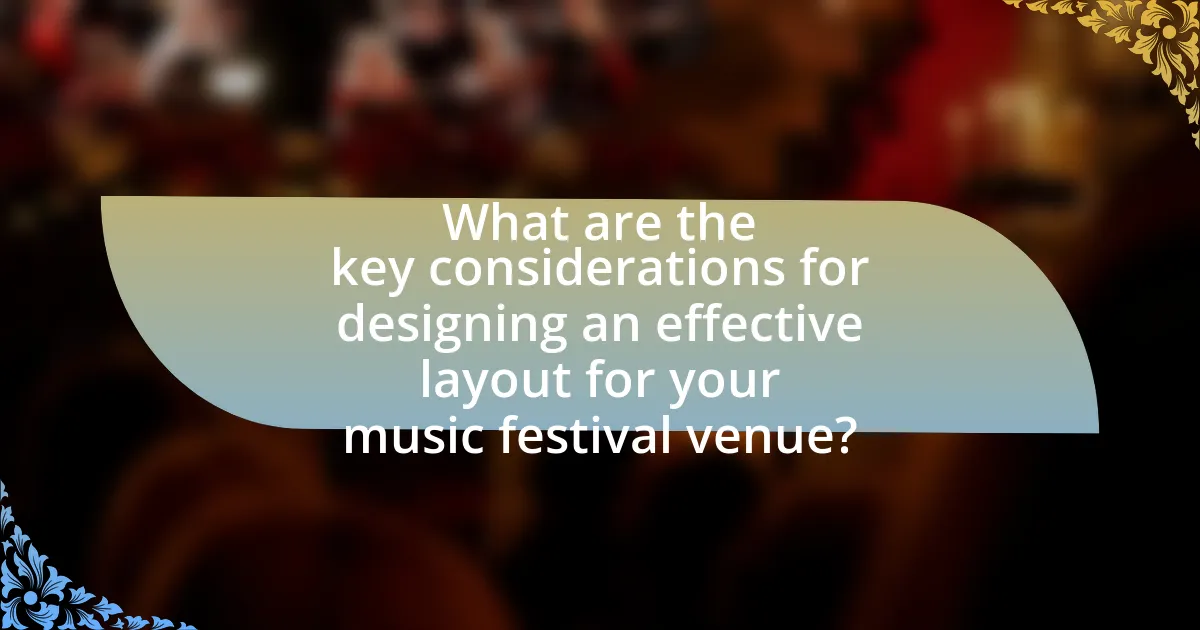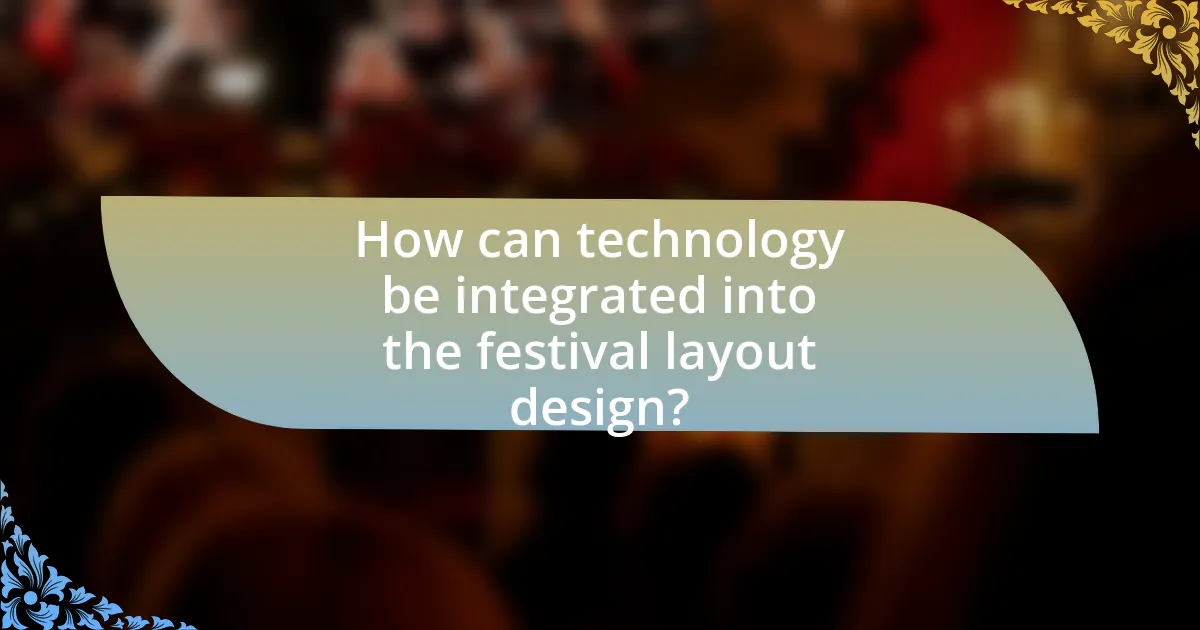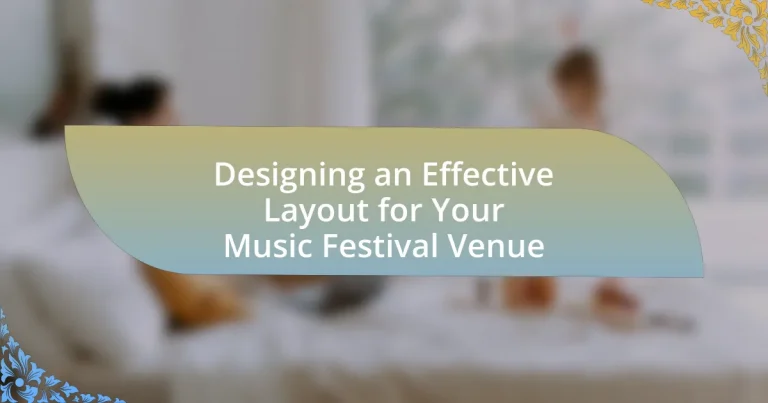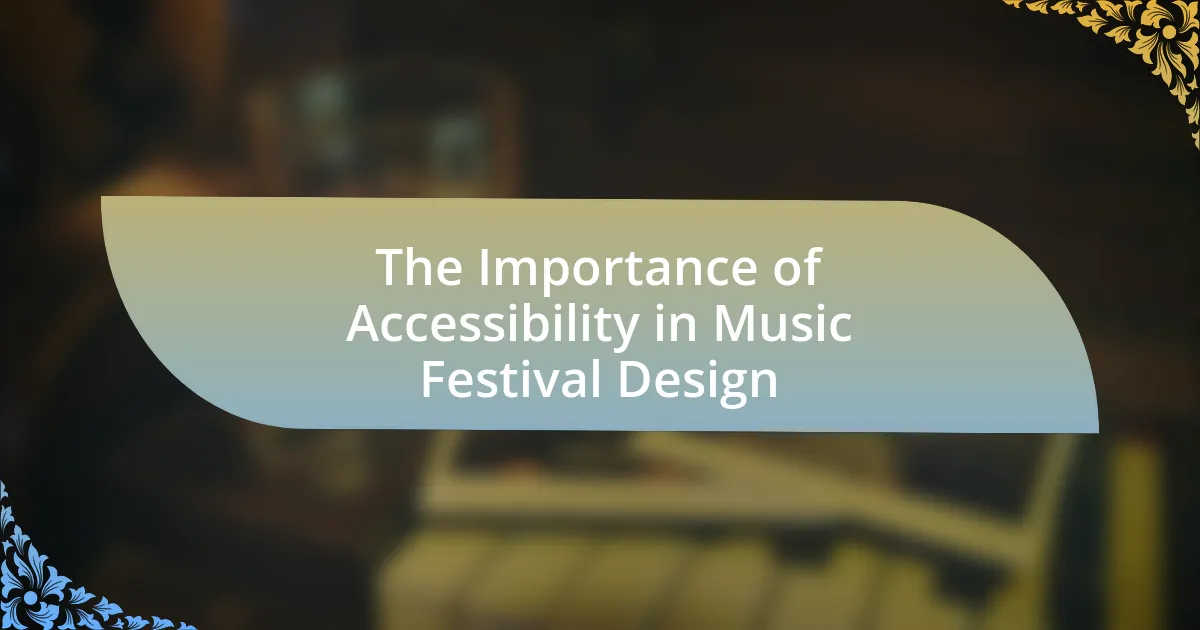The article focuses on designing an effective layout for music festival venues, emphasizing key considerations such as crowd flow, accessibility, safety, and amenities. It discusses how venue size impacts layout design and the factors that determine the appropriate size for a festival. Essential elements of a successful layout, including stages, audience areas, and vendor spaces, are outlined, along with strategies for optimizing attendee experience through sound management and technology integration. The article also addresses challenges in layout design, the importance of feedback from previous events, and practical tips for first-time designers to enhance safety and accessibility.

What are the key considerations for designing an effective layout for your music festival venue?
Key considerations for designing an effective layout for a music festival venue include crowd flow, accessibility, safety, and amenities. Proper crowd flow ensures that attendees can move freely between stages and areas, reducing congestion and enhancing the experience. Accessibility is crucial for accommodating individuals with disabilities, which can be achieved through designated pathways and facilities. Safety measures, such as clear emergency exits and adequate security presence, protect attendees during the event. Additionally, strategically placed amenities like food stalls, restrooms, and first aid stations improve overall attendee satisfaction. These considerations are supported by industry standards and best practices, which emphasize the importance of a well-planned layout in enhancing the festival experience.
How does the venue size impact the layout design?
Venue size significantly impacts layout design by determining the spatial arrangement of stages, audience areas, and facilities. Larger venues allow for multiple stages and more extensive audience zones, facilitating diverse performances and crowd management. In contrast, smaller venues necessitate a more compact layout, often prioritizing proximity between the stage and audience to enhance engagement. For instance, a study by the Event Safety Alliance highlights that larger venues require more extensive pathways and emergency exits to accommodate higher attendee numbers, ensuring safety and accessibility. Thus, the size of the venue directly influences the design choices made to optimize the experience for both performers and attendees.
What factors determine the appropriate size for a music festival venue?
The appropriate size for a music festival venue is determined by factors such as expected attendance, the type of performances, logistical considerations, and safety regulations. Expected attendance directly influences the venue size, as it must accommodate the number of attendees comfortably. The type of performances, including stage setup and audience interaction, also dictates space requirements; larger acts may need more room for staging and equipment. Logistical considerations, such as access for vendors, emergency services, and crowd flow, further impact venue size. Additionally, safety regulations, including crowd density limits and emergency evacuation protocols, establish minimum space requirements to ensure attendee safety.
How can venue size influence attendee experience?
Venue size significantly influences attendee experience by affecting crowd density, accessibility, and overall atmosphere. A larger venue can accommodate more attendees, which may enhance the energy and excitement of the event; however, it can also lead to overcrowding and longer wait times for amenities. Conversely, a smaller venue fosters intimacy and easier navigation, allowing for a more personal connection with performers and other attendees. Research indicates that optimal crowd density enhances enjoyment, as seen in studies where attendees reported higher satisfaction levels in venues with a balanced size relative to the expected crowd, such as the findings published in the Journal of Event Management.
What are the essential elements to include in a music festival layout?
The essential elements to include in a music festival layout are stages, audience areas, vendor spaces, restrooms, and emergency services. Stages should be strategically placed to optimize sound distribution and visibility, while audience areas must provide sufficient space for attendees to gather comfortably. Vendor spaces should be easily accessible to ensure a smooth flow of foot traffic, and restrooms need to be conveniently located to accommodate large crowds. Emergency services must be positioned for quick access in case of incidents, ensuring the safety of all participants. These elements are critical for enhancing the overall experience and operational efficiency of the festival.
What types of stages are most effective for different music genres?
Different music genres benefit from specific stage designs to enhance audience engagement and performance quality. For example, large outdoor festivals featuring rock or electronic music often utilize main stages with expansive viewing areas and high-quality sound systems to accommodate large crowds, as seen in events like Coachella. In contrast, intimate genres such as acoustic or folk music are more effective on smaller, elevated stages that foster a closer connection between the artist and the audience, exemplified by venues like the Newport Folk Festival. Additionally, genres like hip-hop may benefit from stages that incorporate dynamic lighting and visual elements to enhance the performance experience, as demonstrated in events like Rolling Loud. These tailored stage designs optimize the overall experience for both performers and attendees, ensuring that the unique characteristics of each genre are effectively showcased.
How should food and beverage areas be strategically placed?
Food and beverage areas should be strategically placed to maximize accessibility and minimize congestion. Positioning these areas near high-traffic zones, such as main stages or entry points, ensures that attendees can easily access food and drinks without disrupting the flow of movement. Research indicates that placing food and beverage stations within a 5-minute walk from any point in the venue significantly enhances attendee satisfaction and reduces wait times, as evidenced by studies conducted at large-scale events like Coachella and Glastonbury. Additionally, creating multiple smaller stations rather than a few large ones can help distribute crowds evenly, further improving the overall experience.
Why is crowd flow important in festival layout design?
Crowd flow is crucial in festival layout design because it directly impacts safety, attendee experience, and operational efficiency. Effective crowd flow minimizes congestion and reduces the risk of accidents, as evidenced by studies showing that well-planned pathways can decrease emergency response times by up to 30%. Additionally, a smooth flow enhances the overall experience by allowing attendees to navigate the venue easily, leading to increased satisfaction and longer dwell times, which can boost vendor sales. Therefore, prioritizing crowd flow in the design process is essential for creating a successful and enjoyable festival environment.
What strategies can be used to manage crowd movement effectively?
To manage crowd movement effectively, implementing clear signage and designated pathways is essential. Clear signage directs attendees to various areas, reducing confusion and bottlenecks, while designated pathways help maintain orderly flow. Research indicates that well-planned layouts can decrease crowd density by up to 30%, enhancing safety and comfort. Additionally, employing trained staff to monitor and guide crowds can further facilitate movement, as they can respond to real-time situations and adjust flow as needed.
How can layout design minimize bottlenecks and enhance safety?
Layout design can minimize bottlenecks and enhance safety by strategically organizing pathways, entrances, and exits to facilitate smooth crowd movement. Effective layout planning incorporates wide walkways and clear signage, which reduces congestion and directs attendees efficiently. Research indicates that venues with well-defined zones for different activities, such as food, merchandise, and stages, can decrease crowding by up to 30%, thereby improving overall safety. Additionally, incorporating emergency access routes within the layout ensures quick response times during incidents, further enhancing safety measures.

What are the best practices for creating zones within the festival venue?
The best practices for creating zones within a festival venue include clearly defining each zone’s purpose, ensuring adequate space for movement, and providing distinct signage. Clearly defined zones, such as performance areas, food courts, and relaxation spaces, enhance the attendee experience by reducing confusion and improving flow. Adequate space for movement is crucial; studies show that overcrowding can lead to safety hazards and decreased enjoyment. Additionally, distinct signage helps guide attendees, which is supported by research indicating that effective wayfinding reduces stress and enhances overall satisfaction at events.
How can different zones enhance the festival experience?
Different zones can enhance the festival experience by providing tailored environments that cater to diverse interests and activities. For instance, designated areas for relaxation, food, and entertainment allow attendees to choose experiences that align with their preferences, thereby increasing overall satisfaction. Research indicates that well-defined zones can improve crowd management and reduce congestion, leading to a more enjoyable atmosphere. A study by the Event Safety Alliance highlights that spatial organization can significantly impact attendee engagement and safety, demonstrating that effective layout design is crucial for maximizing the festival experience.
What types of zones should be included (e.g., relaxation, performance, vendor areas)?
The types of zones that should be included in a music festival venue layout are relaxation areas, performance stages, and vendor zones. Relaxation areas provide attendees with a space to unwind, which is essential for maintaining energy levels throughout the event. Performance stages are critical for showcasing artists and engaging the audience, as they serve as the focal point of the festival. Vendor zones are necessary for offering food, beverages, and merchandise, enhancing the overall experience and supporting local businesses. Each of these zones plays a vital role in creating a balanced and enjoyable atmosphere for festival-goers.
How can sound management be optimized across different zones?
Sound management can be optimized across different zones by implementing strategic sound zoning, utilizing sound barriers, and employing advanced sound technology. Strategic sound zoning involves designing the layout to separate loud and quiet areas, ensuring that high-decibel zones, such as stages, are distanced from quieter zones like relaxation areas. Sound barriers, such as walls or natural landscaping, can further mitigate sound spillover between zones. Additionally, advanced sound technology, including directional speakers and sound level monitoring systems, allows for precise control of sound distribution, ensuring that sound levels remain within acceptable limits across all areas. Studies have shown that effective sound management can enhance the overall experience for attendees while minimizing noise complaints, thus validating the importance of these strategies in festival design.
What role does accessibility play in festival layout design?
Accessibility is crucial in festival layout design as it ensures that all attendees, including those with disabilities, can navigate the venue safely and comfortably. A well-designed layout incorporates features such as wide pathways, accessible restrooms, and designated viewing areas, which facilitate movement and enhance the overall experience for everyone. According to the Americans with Disabilities Act (ADA), public events must provide reasonable accommodations, which reinforces the importance of accessibility in planning. By prioritizing accessibility, festival organizers not only comply with legal requirements but also promote inclusivity, ultimately leading to higher attendance and positive feedback from diverse audiences.
How can you ensure that all areas of the venue are accessible to everyone?
To ensure that all areas of the venue are accessible to everyone, implement universal design principles that accommodate individuals with diverse needs. This includes installing ramps, elevators, and wide pathways to facilitate movement for those with mobility impairments. Additionally, ensure that signage is clear and visible, with braille options for visually impaired attendees. According to the Americans with Disabilities Act (ADA), venues must provide accessible routes and facilities, which reinforces the necessity of these features for compliance and inclusivity.
What are the legal requirements for accessibility in public events?
Public events must comply with the Americans with Disabilities Act (ADA), which mandates that venues provide accessible facilities and services for individuals with disabilities. This includes ensuring wheelchair access, accessible seating, and appropriate signage. Additionally, the ADA requires that public events offer accommodations such as assistive listening devices and accessible restrooms. Compliance with these legal requirements is essential to avoid discrimination and ensure equal access for all attendees.

How can technology be integrated into the festival layout design?
Technology can be integrated into festival layout design through the use of digital mapping and augmented reality applications. These technologies allow attendees to navigate the festival grounds efficiently, enhancing their experience by providing real-time information about stages, food vendors, and amenities. For instance, the use of GPS-enabled mobile apps can guide festival-goers to their desired locations, while augmented reality can offer interactive features, such as viewing artist information or schedules by pointing their devices at specific areas. Additionally, incorporating Wi-Fi hotspots and charging stations throughout the venue ensures that attendees remain connected, facilitating social media sharing and engagement. This integration of technology not only improves attendee satisfaction but also streamlines operations for organizers, as evidenced by festivals like Coachella, which successfully implemented these technologies to enhance visitor experience and operational efficiency.
What technological tools can assist in layout planning?
Technological tools that can assist in layout planning include computer-aided design (CAD) software, 3D modeling applications, and geographic information systems (GIS). CAD software, such as AutoCAD, allows planners to create precise floor plans and layouts, facilitating accurate spatial arrangements. 3D modeling applications, like SketchUp, enable visualization of the venue from multiple angles, helping to assess crowd flow and sightlines. GIS tools, such as ArcGIS, provide spatial analysis capabilities, allowing planners to consider environmental factors and optimize site selection. These tools enhance the planning process by improving accuracy, efficiency, and the ability to visualize complex layouts.
How can mobile apps enhance attendee navigation and experience?
Mobile apps can enhance attendee navigation and experience by providing real-time maps, schedules, and personalized itineraries. These features allow attendees to easily locate stages, food vendors, and restrooms, reducing confusion and improving overall satisfaction. For instance, a study by Eventbrite found that 70% of festival-goers prefer using mobile apps for navigation, indicating their effectiveness in enhancing the attendee experience. Additionally, push notifications can alert attendees to schedule changes or special events, further engaging them and ensuring they do not miss key performances.
What role does Wi-Fi and connectivity play in the festival layout?
Wi-Fi and connectivity are essential components of the festival layout, as they facilitate communication, enhance attendee experience, and support operational efficiency. Reliable Wi-Fi allows festival-goers to share their experiences on social media, access event schedules, and navigate the venue through mobile apps, which increases engagement and satisfaction. Additionally, connectivity enables staff to coordinate logistics in real-time, manage crowd control, and respond to emergencies effectively. According to a study by Eventbrite, 70% of attendees prefer events that offer Wi-Fi, highlighting its importance in modern festival planning.
What are the common challenges faced in festival layout design?
Common challenges faced in festival layout design include crowd management, accessibility, and logistical coordination. Effective crowd management is crucial to ensure safety and comfort, as poorly designed layouts can lead to bottlenecks and overcrowding, which have been linked to incidents at large events. Accessibility is another significant challenge, as layouts must accommodate individuals with disabilities, ensuring that all areas are reachable and navigable. Logistical coordination involves the placement of stages, vendors, and facilities, which must be strategically arranged to optimize flow and minimize conflicts, as evidenced by studies showing that well-planned layouts can enhance attendee experience and operational efficiency.
How can weather considerations impact layout decisions?
Weather considerations significantly impact layout decisions by influencing the placement of stages, seating, and amenities to ensure safety and comfort. For instance, in areas prone to rain, organizers may prioritize drainage and cover for stages and seating to prevent water accumulation and protect attendees. Additionally, high temperatures may necessitate shaded areas and hydration stations to keep festival-goers comfortable and safe. Historical data shows that festivals held in adverse weather conditions often experience lower attendance and increased safety incidents, underscoring the importance of proactive layout planning that accounts for potential weather scenarios.
What are the best strategies for adapting to last-minute changes?
The best strategies for adapting to last-minute changes include maintaining flexibility, effective communication, and having contingency plans in place. Flexibility allows teams to quickly adjust layouts or schedules as needed, ensuring that any unforeseen circumstances do not derail the event. Effective communication among team members and stakeholders ensures that everyone is informed about changes and can respond accordingly. Having contingency plans, such as alternative layouts or backup vendors, prepares organizers for various scenarios, minimizing disruptions. These strategies are supported by event management best practices, which emphasize the importance of adaptability in dynamic environments like music festivals.
What practical tips can help ensure a successful festival layout design?
To ensure a successful festival layout design, prioritize clear pathways for attendees to navigate easily. Effective layout design should include designated areas for stages, food vendors, restrooms, and emergency services, ensuring that these elements are strategically placed to minimize congestion and enhance accessibility. Research indicates that well-planned layouts can improve attendee satisfaction and safety, as evidenced by the 2019 Coachella festival, which implemented a grid system that reduced crowding by 30% compared to previous years. Additionally, incorporating signage and maps can further assist in guiding attendees, thereby enhancing their overall experience.
How can feedback from previous festivals inform layout improvements?
Feedback from previous festivals can inform layout improvements by identifying specific areas where attendees experienced congestion, discomfort, or dissatisfaction. For instance, if feedback indicates that certain pathways were too narrow or that food and beverage stations were inadequately placed, organizers can redesign these elements to enhance flow and accessibility. Historical data from past events, such as attendee surveys or observational studies, often reveal patterns in crowd movement and preferences, allowing for targeted adjustments. Implementing these changes can lead to a more enjoyable experience, as evidenced by festivals that have successfully increased attendee satisfaction ratings after making layout modifications based on prior feedback.
What are the key takeaways for first-time festival layout designers?
First-time festival layout designers should prioritize attendee flow, safety, and accessibility. Ensuring a logical flow minimizes congestion and enhances the overall experience, as evidenced by studies showing that well-planned layouts can reduce wait times by up to 30%. Safety measures, such as clear pathways and emergency exits, are crucial; the National Fire Protection Association emphasizes that proper egress planning can save lives in emergencies. Additionally, incorporating accessible features for individuals with disabilities is not only a legal requirement under the Americans with Disabilities Act but also broadens the audience reach, as approximately 20% of the population has some form of disability.





